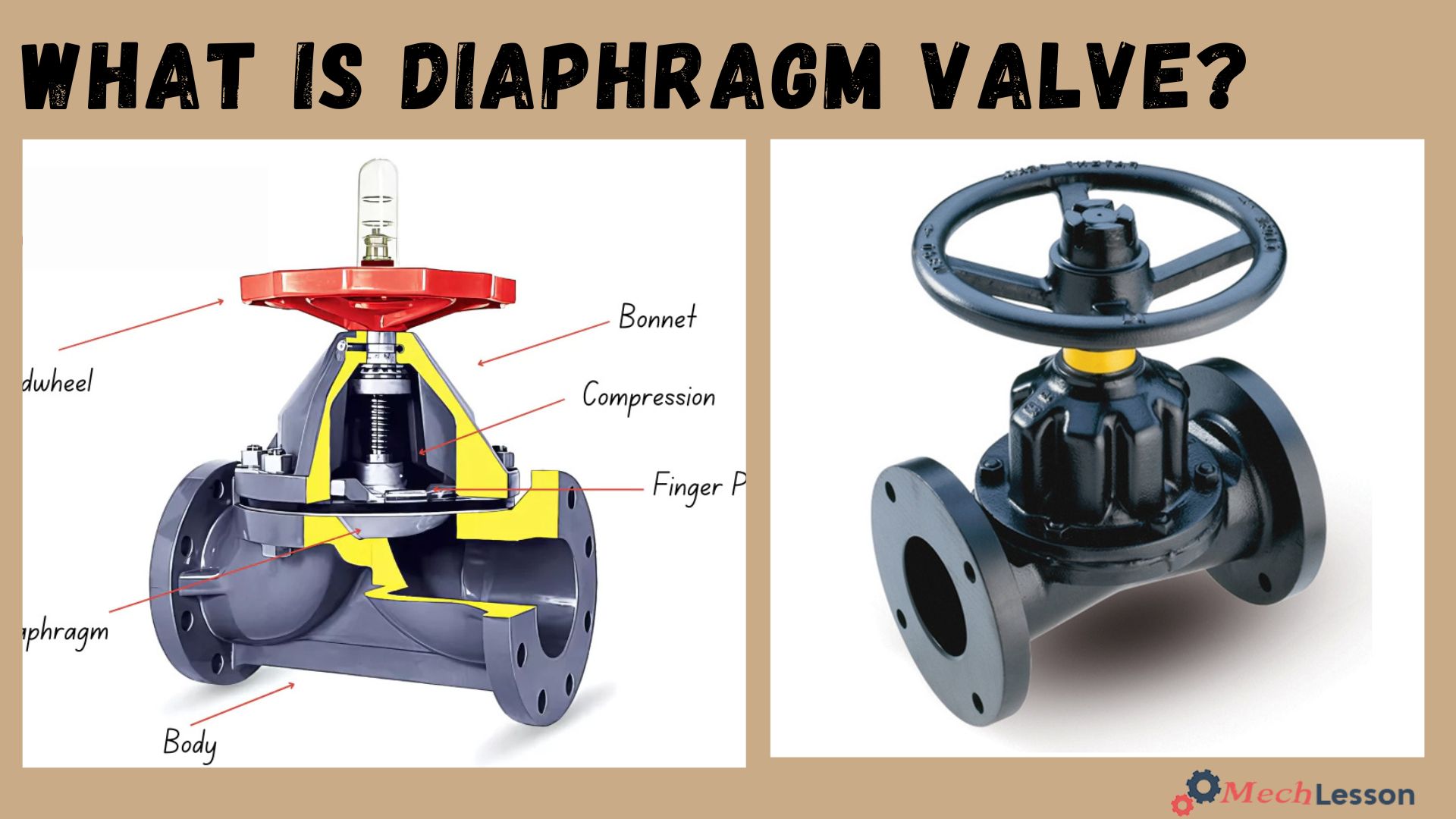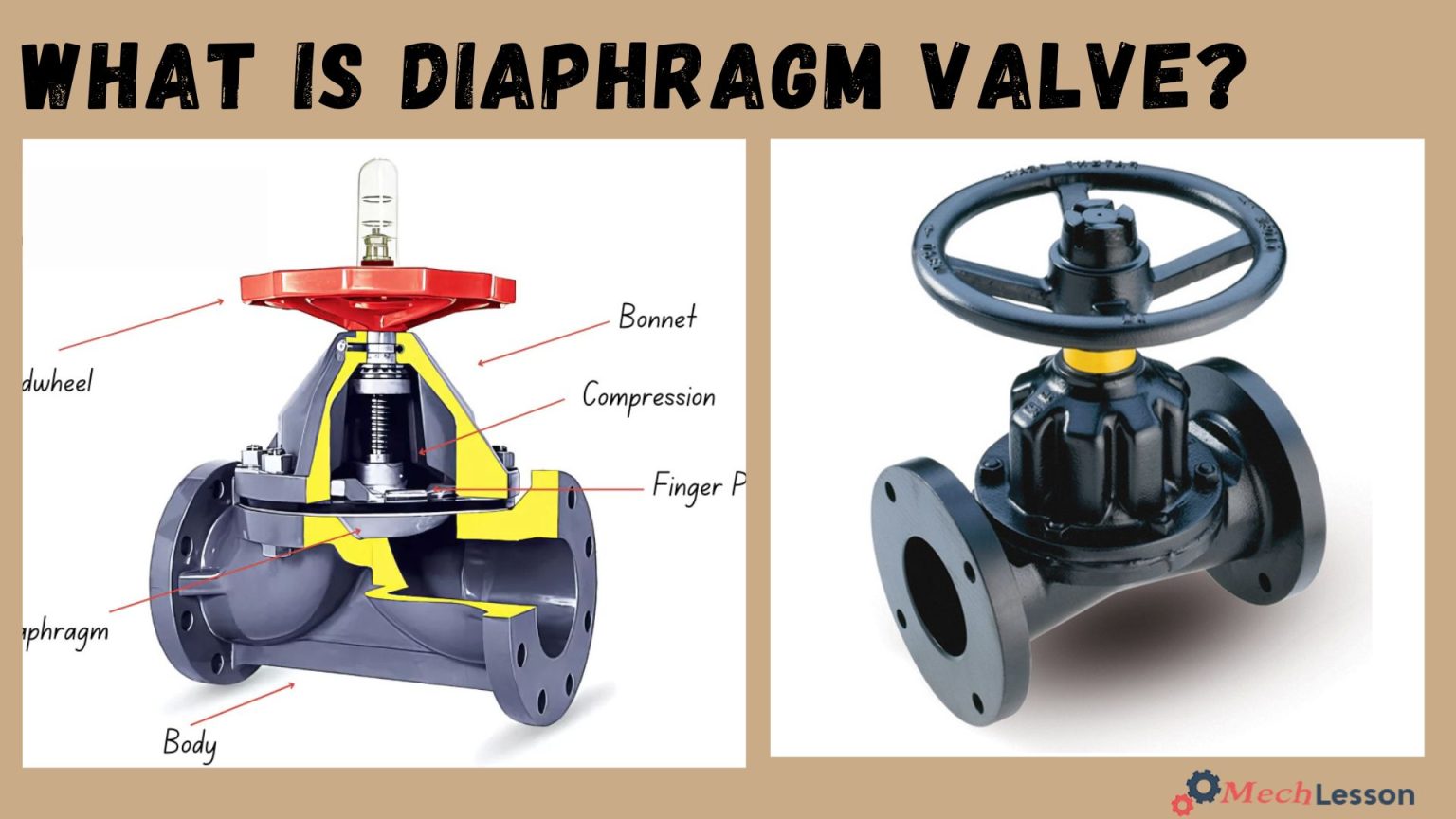Diaphragm valves, also known as membrane valves, consist of a valve body with two or more ports, an elastomeric diaphragm, and a “weir or saddle” or seat upon which the diaphragm closes the valve.
The diaphragm valve controls the fluid flow rate by shifting the diaphragm’s position. The valve closes, and the flow is stopped when the diaphragm presses firmly against its seat. These valves use a linear movement mechanism to regulate and control the fluid flow.
Well, in this reading, we’ll explore what a diaphragm valve is, its applications, parts, diagram, types, materials, and how it works. We’ll also discuss its advantages and disadvantages.
Let’s begin!
You should learn about Ball Valve with this detailed guide!
What is a Diaphragm Valve?
A diaphragm valve is also referred to as a membrane valve. By blocking, controlling, or isolating fluid flow, this flexible diaphragm acts as a flow control device.
An elastomeric diaphragm that seals against a seat to regulate fluid flow is a characteristic of a diaphragm valve.
The diaphragm valve controls the fluid flow rate by shifting the diaphragm’s position. The valve closes, and the flow is stopped when the diaphragm presses firmly against its seat. By use of a linear movement mechanism, these valves regulate and control the fluid flow.
Diaphragm valves, so named because of the flexible disc that stops flow when it comes into contact with the valve seat, use this pressure-responsive diaphragm to generate the force required to open, close, or adjust the valve’s operation.
Diaphragm valves work by using the diaphragm, as opposed to pinch actuators, which employ a liner in the valve body.
The stem, bonnet, compressor, diaphragm, and actuator of a diaphragm valve are composed of steel, brass, wood, and plastic. Since more robust materials are needed for demanding and stressful applications, the selection of materials depends on the valve’s function and purpose.
One essential part of these valves is the diaphragm, which is usually made of flexible materials like rubber or plastic.
Because of its toughness and endurance, ethylene propylene diene monomer (EPDM) is frequently used in combination with polypropylene. More emphasis will be made on this.
Applications
Diaphragm valves are used in various applications today due to their features, including corrosion-resistant material and workings, among others. They are used for clean or dirty water and air service applications.
Diaphragm valves are also used in demineralized water systems and corrosive applications. They are also used in vacuum services, the red waste system in nuclear facilities, food processing, pharmaceuticals, and brewing systems.
You should also learn about Diaphragm Valve with this detailed guide!
Parts of a Diaphragm Valve
Below are the major parts of a diaphragm valve:
- Bonnet
- Valve Body
- Diaphragm
- Compressor
- Stem
- Actuator
- Position Indicators
- Connections —Threaded Connections
Diagram

Learn about PCV Valve with this detailed guide!
Types of Diaphragm Valve
Straight and weir diaphragm valves are the two main kinds of diaphragm valves.
Straight-Through Diaphragm Valves
In a straight-through diaphragm valve, a flat-bottomed valve body reduces flow resistance and enables fluid to flow in a straight line.
The diaphragm of the straightway valve raises high to allow for complete streamline flow in either direction when it is open. Even with fibrous or gritty materials in the line, the diaphragm tightly seals when the valve is closed, ensuring positive closure.
The diaphragm has to seal against the valve body’s bottom in order to reach a fully closed state. Because of its shorter service life, this design calls for a more flexible diaphragm material and more frequent replacements.
When handling semi-solid media, such as slurries, sludges, and viscous fluids, when little blockage is required, these valves work effectively. Additionally, because there are no saddles to block flow reversal, straight-through diaphragm valves can handle bi-directional flow.
The food and beverage industry is the one that uses full-bore valves the most. Without opening or removing the valve from the line, it enables ball-brush cleaning using steam or caustic soda.
Weir Diaphragm Valves
Weir diaphragm valves are frequently utilized in throttling applications because of their exceptional ability to regulate fluid flow, even at low flow rates. They could use a two-piece compressor system, which makes a little hole in the middle of the valve.
In the early phases of stem movement, the inner compressor first raises the center portion of the diaphragm rather than the entire diaphragm. More accurate flow control is made possible by the outer compressor lifting in tandem with the inner compressor after it is fully lifted.
One of the most widely used designs of diaphragm valves is the weir type. It has a raised saddle or lip where the diaphragm contacts it to create a seal.
By shortening the diaphragm’s travel distance between fully open and closed, this design lessens the strain the diaphragm experiences when operating.
Consequently, a thicker material may be used to make the diaphragm, which makes it appropriate for situations where high-pressure or vacuum conditions are present.
It is advised to use bonnet assemblies while handling hazardous fluids. In the event that the diaphragm fails, these components seal the valve to stop any leaks. Diaphragm valves are a fantastic option for food processing applications since they are also self-draining.
Clean, uniform liquids and gases may be handled using Weir diaphragm valves. However, because sediments and high-viscosity fluids can build up on the saddle, they might not be the best choice for these types of fluids. Additionally, they may transport abrasive, dangerous, and caustic materials.
You should learn about gate valve with this detailed guide!
Based on the applications of diaphragm valves, they can also be categorized into:
- Sanitary Diaphragm Valves
- Biotech Valves
- Hygienic Valves
- Process Valves
- Process Valves
How Does a Diaphragm Valve Work?
The working of diaphragm valves is simple to use. When the valve is open, a valve actuator touches the inner membrane, also known as the “diaphragm.”
The membrane is forced into the solid dam’s edge when the actuator is rotated or squeezed, closing the valve when the user wants it to.
The membrane of some diaphragm valves can be partially closed in half-open or limited states, which permits a throttled flow through the valve. We shall look at the general types of diaphragm valves and their applications in the next section.
A flexible diaphragm used in diaphragm valves is joined to a compressor by a stud that is molded into the diaphragm. The diaphragm is forced into contact with the bottom of the valve body to achieve shut-off, as opposed to pinching the liner closed.
Because they provide a precise and variable opening for controlling the pressure drop through the valve, manual diaphragm valves are perfect for flow control. Until the necessary volume of media is passing through the system, the handwheel is rotated.
For start and stop applications, the handwheel is rotated until the compressor lifts off the bottom of the valve body until the flow may pass through or presses the diaphragm against the bottom to stop the flow.
Learn about EGR Valve with this detailed guide!
Advantages and DIsadvantages of a Diaphragm Valve
Diaphragm valves are suitable for on-off and throttling service, offering good chemical resistance and eliminating stem leakage. They provide bubble-tight service and are suitable for slurries and viscous fluids, making them suitable for hazardous chemicals and radioactive fluids.
They are used extensively in food processing, pharmaceuticals, and brewing applications that cannot tolerate contamination.
However, they have limitations such as preventing full drainage of piping, working temperatures and pressures being limited by the diaphragm material, and potential erosion in severe throttling service containing impurities.
Also, diaphragm valves are available in limited sizes, usually NPS ¹⁄₂ to 12 (DN 15 to 300).
You should learn about Butterfly Valve with this detailed guide!
FAQs
What is a diaphragm valve used for?
A diaphragm valve makes use of a flexible diaphragm to control, obstruct, or isolate the flow of fluids. They can handle liquids, gaseous fluids, and semi-solid media such as slurries, colloids, sludges, and brackish water.
What are diaphragm valves used primarily for?
Diaphragm valves are primarily used for isolation and control of high-pressure and/or high-temperature services involving corrosive fluids. In addition, they provide a positive shut-off when necessary, allowing for accurate measurement and isolation at pressures up to 5,000 psi or 3,600 bar.
What is the difference between a ball valve and a diaphragm valve?
A hollow, perforated, pivoting ball controls the flow through it. The ball rotates around an axis perpendicular to the flow. Diaphragm valves provide a flexible elastomeric diaphragm consisting of a valve body and a seat onto which the diaphragm shuts. The diaphragm valve provides rapid shutoff and precise actuation.
What is a point-of-use diaphragm valve?
Valve body structure available in straight-through, two-way, three-way, U-type, T-type, tank bottom valve, and multi-channel diaphragm valve. It features no dead angle, non-retention, cost-effectiveness, easy maintenance, and no need for additional tools.
What is the difference between a gate valve and a diaphragm valve?
The gate valves use a sliding gate to allow or stop fluid flow through pipelines, while diaphragm valves use a flexible diaphragm to regulate fluid flow. Gate valves have high-flow capacity, ease of operation, and are suitable for low-pressure applications.

